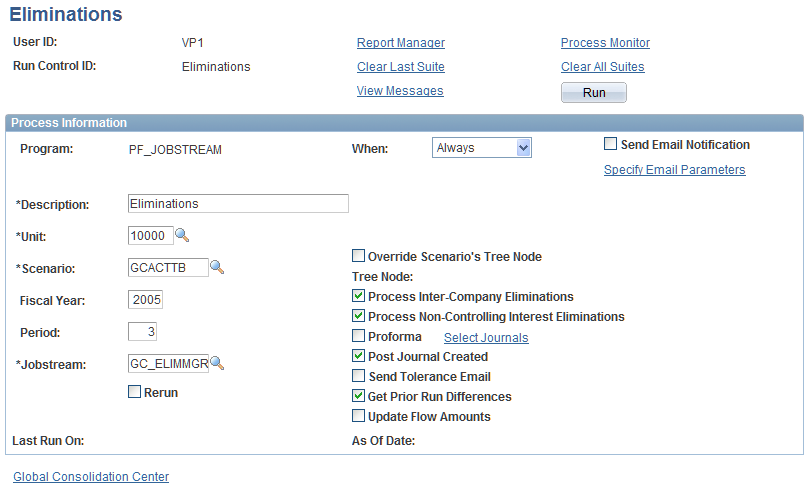Processing Eliminations
This section provides an overview of elimination processing and discusses how to run the Elimination application engine.
Pages Used to Process Eliminations
|
Page Name |
Definition Name |
Navigation |
Usage |
|---|---|---|---|
|
Eliminations run control |
RUN_GC_CONSL |
|
Run the Elimination application engine. |
|
Journal Selection |
RUN_GC_JRNL |
Click the Select Journals link on the Eliminations run control page. |
Select which journals to include when using the proforma option. |
Understanding Elimination Processing
Use the Elimination run control page to process eliminations, which eliminates or cancels out the effects of intercompany transactions and non-controlling interests. When you process eliminations, you can opt to process intercompany eliminations, non-controlling interest eliminations, or both.
When running the intercompany elimination process, the system:
Resolves data from the consolidation ledger (CLED) into the ILOG, based on the elimination rules for the consolidation model, the fiscal year, and period that you specify in the run control, and adds a sequence number key to each row.
Processes eliminations on the resolved ILOG data by creating entries in the OLOG to the specified elimination target ChartFields with a reversed sign, booking the entries to the elimination entity for that node.
After populating the OLOG with the elimination entries, calculates the out-of-balance amount from the OLOG lines and creates the out-of-balance entries to the OLOG.
Creates reversal entries for eliminations, if necessary.
This step depends on the processing method, which is established on the Ledger Template page for the consolidation ledger. The system creates reversal entries only if you are using a trial balance format and processing year-to-date, except when you are processing the last accounting period of the year.
Note: Steps one through four use temporary (work) tables.
Merges the temporary ILOG and OLOG tables into their permanent tables, GC_ILOG_XXX_TBL and GC_OLOG_XXX_TBL, respectively.
Creates the journal lines in the journal table with a GC_SOURCE of 04 (elimination entry).
Posts the journals to the consolidation ledger (CLED), if you choose to automatically post them.
If you are processing a rerun, during the initial stages of processing, the system unposts any posted journals from the prior run that affect the same data, or the system deletes them if they weren't posted. If you rerun using a different consolidation tree node, the system only unposts (or deletes) journals from the prior run that were recorded against nodes within the tree node now being processed.
When you run the non-controlling interest eliminations process, the system:
Resolves the data for the subsidiary equity accounts from the CLED into the ILOG, and adds a sequence number key to each row.
Resolves the data for the parent investment accounts from the CLED into the ILOG.
Eliminates the subsidiary equity data by creating the entries in the OLOG to the specified elimination target ChartFields with a reversed sign, booking the entries to the elimination entity.
Similarly, eliminates the parent investment data, generates non-controlling interest adjustments, and creates out-of-balance amounts in the OLOG, if applicable.
Creates reversal entries for the non-controlling interest eliminations, if necessary.
This step depends on the processing method, which is established on the Ledger Template page. The system creates reversal entries only if you are using a trial balance format and processing year-to-date, except when you are processing the last accounting period of the year.
Note: Steps one through five use temporary (work) tables.
Merges the temporary ILOG and OLOG tables into their permanent tables, GC_ILOG_XXX_TBL and GC_OLOG_XXX_TBL, respectively.
Creates the journal lines in the journal table with one of these GC_SOURCE values:
Posts the journals to the consolidation ledger (CLED), if you choose to automatically post them.
Note: If you are using the financial statement consolidation ledger format, you must run the non-controlling interest eliminations after the equitization process. In this way, the system properly eliminates the additional investment from the equitization process.
Eliminations Run Control Page
Use the Eliminations run control page (RUN_GC_CONSL) to run the Elimination application engine.
Image: Eliminations run control page
This example illustrates the fields and controls on the Eliminations run control page. You can find definitions for the fields and controls later on this page.

Select any of these processing options: